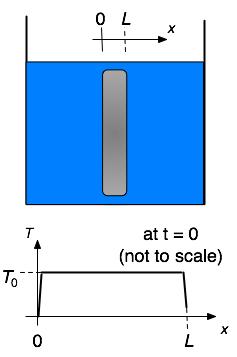
Problems for
Intermediate Methods in Theoretical Physics
Edward F. Redish
 |
Problems for Edward F. Redish |
The diffusion equation:
can be used to describe many things, from the spreading out of perfume molecules from an open bottle, to the flow of heat, to the propagation of electrons (the last if D is taken to be complex). Consider the temperature of a large but thin plate of material imbedded in a heat bath. Treat this as a uniform 1-D system (ignoring the spatial variation of T in the y and z directions of the plate) with ψ = T(x,t), the temperature in the interior of the slab as a function of distance and time. We can rescale our thermometer for convenience to choose the temeperature of the heat bath as 0. A moment after its imbedding into the heat bath, the slab has a teperature T0 in its interior, falling precipitously to 0 at its edges as shown in the graph at the right. |
 |
(a) Assume that the time and space dependence of T(x,t) can be separated, T(x,t) = f(x)g(t) and use a separation constant to obtain ordinary differential equations for f and g.
(b) Use a physical argument to choose the sign of your separation constant as it appears in the time equation and solve the equation.
(c) Find the general solution to the space equation given the boundary conditions, T(0,t) = 0 and T(L,t) = 0 for all t.
(d) Explain how you would go about finding T(x,t) for t > 0 and write equations that would allow you to calculate that function if you had a computer available.
| University of Maryland | Physics Department | Physics 374 Home |
|---|---|---|
 |
 |
 |
Last revision 7. December, 2005.